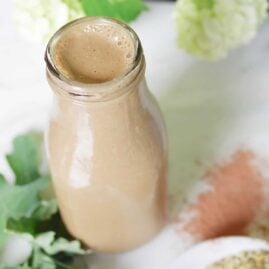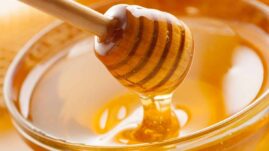On the surface, peanut butter looks like the perfect diabetes-friendly food: it’s moderately low in carbohydrates, full of healthy fats, and is loaded with protein.
It’s also vegan, relatively inexpensive, and can pair well with many other foods. But is it actually good for people living with diabetes?
This article will explain the health benefits and health costs of peanut butter, and how you can incorporate it into your diet.

Nutrition in peanut butter
Peanut butter is nutritionally dense. A serving (2 tablespoons or 32 grams) of peanut butter without any added ingredients contains:
| Calories | 191 |
| Fat | 16.4 g |
| Protein | 7.2 g |
| Carbs | 6.1 g |
| Fiber | 1.5 g |
| Sugar | 3.4 g |
Source: Food Data Central
It also contains B vitamins, vitamin E, vitamin K, and magnesium.
Magnesium is especially important for people with prediabetes or type 2 diabetes who often have low magnesium levels.
Studies have shown that supplementing magnesium may offer protection from type 2 diabetes by improving insulin sensitivity and reducing inflammation.
How peanut butter affects blood sugar
Peanut butter without any added sugar has a low glycemic index (GI) of 13 and only 6 grams of carbs per serving, so it only has a small effect on blood sugars (unless you eat a lot of peanut butter).
However, peanut butter is rarely eaten alone. It’s often paired with carbohydrates like oatmeal, apples, or toast.
When painting peanut butter with a sweeter snack, like an apple, the blood sugar spike is delayed because the fat and protein in the peanut butter slow down the digestion of the carbohydrates from the apple.
So combining carbohydrates with peanut butter actually makes your blood sugar spike less than if you ate only the carbohydrates.

If you manage your diabetes with oral medications (like Metformin) or diet and exercise, the flatter blood sugar curve is great news, as it makes it easier to keep your blood sugar stable throughout the day.
If you manage your diabetes with insulin, adding peanut butter to your diet can also be beneficial, but you need to adjust your insulin dosing to match the flatter blood sugar curve.
How to manage insulin dosing while eating peanut butter
Since peanut butter slows the digestion of carbohydrates, it’s not as important to pre-bolus insulin as aggressively as you would if you were eating a higher carbohydrate snack, like pretzels, for example.
However, you may want to experiment with different types of boluses, especially if you’re on an insulin pump.
Different dosing types like a square bolus, dual wave bolus, or extended bolus can give you a little bit of insulin up front for the carbohydrates you’re eating, while also giving you an extra bolus several hours later.
This can help to mitigate any high blood sugars from the delayed digestion due to the fat and protein content of the peanut butter.
Always check with your doctor or diabetes educator first before making any changes to your insulin regimen.
How to make peanut butter a healthier snack if you have diabetes
Peanut butter is a great, filling snack, but its fat and protein load can make it hard to bolus insulin. Ways to make that easier include:
Opt for eating peanut butter with lower carbohydrate foods, like unsweetened Greek yogurt, in protein shakes, or with celery sticks and carrots. When paired with heart-healthy foods, eating peanut butter has been shown to reduce the risk of cardiovascular disease in women with type 2 diabetes!
Eat peanut butter earlier in the day, so you don’t experience delayed high blood sugar while you’re asleep.
One study found that eating peanut butter at breakfast helped to not only curb appetite for the rest of the day, but it kept blood sugars stable throughout the course of a day, as well! This is in part due to the heart-healthy magnesium found in peanut butter.
Experiment with different bolusing schemes if you’re on an insulin pump, or break your dose into two, if you’re only multiple daily injections (MDI)
Choose all-natural peanut butter varieties, where the only ingredients are peanuts. Avoid “honey-roasted” varieties, that have sugar and sweeteners added
If you’re looking to lose weight, limit portion sizes, as peanut butter is not a low-calorie snack!
The downsides of eating peanut butter
While peanut butter is a delicious, filling snack that is portable, vegan, and relatively cheap, there are some downsides to be cognizant of as well.
Added salt, sugar, and process oils
Always choose a peanut butter that’s only ingredients are peanuts! Many types of peanut butters have added fats, processed oils, and sugars, which can make eating it if you have diabetes (as well as dosing insulin!) more difficult.
It’s usually not eaten solo
Peanut butter is great, but it’s most likely to be paired with something that’s higher in carbohydrates, like toast, cereals, sweetened yogurts, or fruit.
This can make taking insulin for it more difficult, and it also makes it a more calorie-dense snack. Smarter pairings for peanut butter include strawberries, celery, sweet potato, unsweetened yogurt, or 100% dark chocolate.
It’s a high-calorie snack
To be clear: peanut butter is not a low-calorie food, and eating too much of it can cause weight gain.
Two tablespoons of peanut butter contain about 200 calories, and because it’s a food that’s not often eaten alone, that can make a pretty substantial snack.
Be wary of eating peanut butter straight out of the jar (always use a measuring spoon!), and watch portion sizes if you’re watching your weight or trying to lose weight.
Peanut allergies
Peanut allergies can be fatal, due to anaphylaxis, and they’re fairly common. About 1 in 50 children in the United States alone have a peanut allergy, however, about 1 in 5 will outgrow the allergy by the time they reach adulthood.
Unfortunately, there is no cure for peanut allergies, but exposing your children early and often to peanuts can help prevent an allergy from developing.
One study found that 17% of babies who did not eat peanuts went on to develop a peanut allergy by age 5, whereas only 3% of those who were exposed to them developed an allergy by age 5.
Always first work with your child’s pediatrician about when it is best to introduce peanut butter into their diet to help prevent the development of an allergic reaction. The timing may depend on many factors, including the health history of both mother and child.









Billie
If you mix your PNB with a little water you won’t have a dense, gooey spread. You’ll have a lighter, airier mixture that is easier to work with.
Donna
Can you give me some good choices of peanut butter or nut butter brands that you have tried with the good fats. Thank you
Christel Oerum
I don’t stick to a specific brand but always choose nut butter without any added sugar. All I want in the jar is nuts and salt
Becky
I Easy Snap is no sugar peanut butter. I mean I love it. My roommate doesn’t like it because it doesn’t have sugar but it works for me.
Edward
Didn’t know that peanut butter is that good for diabetes patient. Thanks for the lovely post.
Fourester
I prefer powdered peanut butter mixed with 100% cacao dark chocolate powder, heavy cream, unsweetened coconut flakes and sugar-free caramel syrup as a mid-afternoon snack. If I have some homemade flax bread, I may spread it on there, but usually just eat with a spoon.
Ivan
I love peanut butter on toast, toasted English muffins and toasted bagels. I eat these daily along with peanut butter flavered donuts.
Ricky Burton
I do love peanut butter. It has to be one of my go-to foods for snacking and, even better, knowing it’s good for you. Thank you for your informative post.